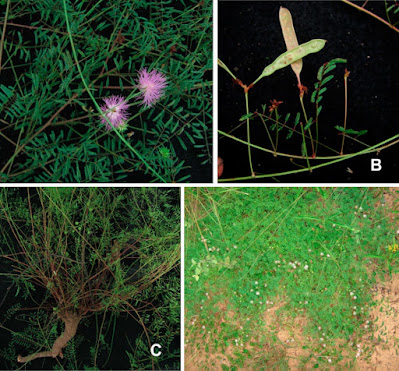 |
| Mimosa carolina M.Morales & Marc.F.Simon, in Morales, Fortunato et Simon, 2020. |
Abstract
Mimosa carolina (Leguminosae), a new species from the Parque Nacional Chapada das Mesas, located in the northern limit of the Brazilian Cerrado, is described and illustrated. In addition, a phylogenetic reconstruction was performed to recover the position of this species in relation to the main clades of the genus Mimosa. This new species is assigned to sect. Habbasia ser. Bipinnatae and exhibits relevant morphological differences with all described species of this series, most notably the prostate habit, glabrous stems, and absence of internal spicules. Our results indicate that this new entity is clearly nested in a strongly supported clade with other striated-corolla species of ser. Bipinnatae. Therefore, ser. Bipinnatae appears to be monophyletic, and a morphologically and ecologically cohesive group within Mimosa. An updated identification key for this series is provided.
Keywords: Brazil; Cerrado; Fabaceae; Maranhão; morphology; taxonomy; trnD-trnT
 |
| Mimosa carolina. (A). Prostate habit. (B). Immature fruits. (C). Base of plant with several slender branches arising from a wood xylopodium. (D). Inflorescence. Photos by Marcelo Simon. |
Mimosa carolina M.Morales & Marc.F.Simon, sp. nov.
Mimosa carolina is similar to the widespread M. somnians Humb. & Bompl. ex Willd, from which it differs by a prostrate habit with slender stems (vs. erect subshrub with robust stems), that are glabrous (vs. pubescent to hispid, rarely glabrous), and unarmed (vs. sometimes armed), shorter pinnae (4–8 mm long) with 6–10 pairs of leaflets (vs. pinnae 10–55 mm long with 13–50 pairs of leaflets), the insertion of pinnae on leaf rachis v-shaped (vs. insertion of pinnae straight on the leaf rachis), and the absence of interpinnal spicules (vs. interpinnal spicules present); it differs from the poorly known M. leptorhachis Benth. by the prostrate habit (vs. erect), glabrous stems (vs. hispidous), insertion of pinnae on leaf rachis v-shaped (vs. insertion of pinnae straight on the leaf rachis) and absence of interpinnal spicules (interpinnal spicules present). In addition, it differs from M. brachycarpa Benth. by its prostrate habit (vs. erect 1–2 m tall), petioles which are 25–45 mm long (vs. 1–10 mm long) and larger (36–40 mm long), and glabrous fruits (vs. fruits 12–18 mm long, densely setose).
Etymology: The epithet refers to Carolina, the municipality of Maranhão State in Brazil where the collection site is located.
Matías Morales, Renée H. Fortunato and Marcelo Fragomeni Simon. 2020. A New Species of Mimosa L. ser. Bipinnatae DC. (Leguminosae) from the Cerrado: Taxonomic and Phylogenetic Insights. Plants. 9(8); 934. DOI: 10.3390/plants9080934
